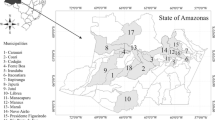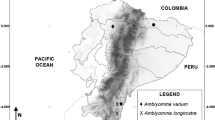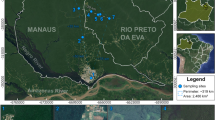Abstract
Only a few aspects of the biology of Amblyomma parvitarsum Neumann are known. Adults of this hard tick species are parasites of South American camelids in the Andean plateau of Argentina, Bolivia, Peru and Chile and also in the Argentine Patagonia, but they have been also rarely found on other artyodactils and two species of birds. The larva has been collected from reptiles in northern Chile, whereas the hosts for the nymph remain unknown. On nine localities included within Altitude Tropical and Perarid Mediterranean ecoregions in northern Chile, we analyzed 237 reptiles, 285 birds, 624 rodents and 52 camelids for infestation with A. parvitarsum to calculate seasonal prevalence of this tick. We also reviewed the literature of this tick and three entomological collections for obtaining and summarizing all the information to date about this tick. None of the analyzed birds and rodents were parasitized with A. parvitarsum; however, seven over a total of ten reptile species that we caught were infested with the larva. In the camelid species Lama glama and Vicugna pacos we collected adult specimens of this tick. Larval prevalence was higher during fall (75 %) in Liolaemus pleopholis in the Altitude Tropical ecoregion. We also collected adult specimens of A. parvitarsum from camelid manure heaps during summer in Salar de Surire and Llullaillaco localities. Additionally, we also reviewed the literature of this tick and examined specimens in three entomological collections for obtaining and summarizing all the information to date about this tick. By this study, nine localities and seven new hosts are added for A. parvitarsum and we confirm reptiles as specific hosts of this tick larva.

Similar content being viewed by others
References
Aguirre DH, Viñabal AE, Cafrune MM (1997) Sobre la biología de Amblyomma parvitarsum Neumann, 1901 (Acari: Ixodidae). Vet Arg 24(131):32–33
Aragão H (1935) Observações sobre os ixodideos da república Argentina. Mem Inst Oswaldo Cruz 30(3):519–533
Aragão H (1938) Nota sobre os ixodoideos da república Argentina. Mem Inst Oswaldo Cruz 33(2):319–327
Arce de Hamity M, Ortiz F (2004) Ectoparásitos (Insecta y Arachnida) sobre animales domésticos de la quebrada de Humahuaca y puna (Jujuy, Argentina). IDESIA 22(1):55–56
Becker GK, Silva RP, Sinkoc AL, Brum JGW (1997) Amblyomma parvitarsum, Neumann, 1901 (Acari: Ixodidae) in Magellanic penguins Spheniscus magellanicus (Spheniscidae) in Cassinos beach, Rio Grande do Sul, Brazil. Arq Inst Biol (São Paulo) 64(1):81–82
Beltrán-Saavedra LF, Limachi JM, Guglielmone AA (2011) Registro de vicuñas (Vicugna vicugna, Molina 1782) como hospedador de Amblyomma parvitarsum Neumann, 1901 (Acari: Ixodidae) en Bolivia. J Selva Andina Res Soc 2(2):40–44
Benoit JB, Lopez-Martínez G, Phillips SA, Elnitsky MA, Yoder JA, Lee RE, Denlinger DL (2008) The seabird tick, Ixodes uriae, uses uric acid in penguin guano as a kairomone and guanine in tick feces as an assembly pheromone on the Antarctic Peninsula. Polar Biol 31:1445–1451
Boero JJ (1944) Notas ixodológicas. II. Nueva lista de los ixodoideos argentinos y sus huéspedes. Rev Asoc Méd Arg 58:354–355
Boero JJ (1954) Los ixodoideos de la República Argentina y sus huéspedes. Rev Fac Agr y Vet (La Plata) 13:505–514
Boero JJ (1957) Las garrapatas de la República Argentina (Acarina: Ixodoidea). Universidad de Buenos Aires, Buenos Aires
Boero JJ (1959) Acarina–Ixodoidea. In: Primeras Jornadas Entoepidemiológicas Argentinas. Buenos Aires, Argentina, pp 595–596
Camicas JL, Hervy JP, Adam F, PC Morel (1998) Les tiques du monde. Nomenclature, stades décrits, hôtes, répartition (Acarida, Ixodida). Orstom, Paris
Dale WE, Venero J (1977) Insectos y ácaros ectoparásitos de la vicuña en Pampa Galeras. Ayacucho. Rev Peru Entomol 20(1):93–99
Di Castri F (1968) Esquisse écologique du Chili. In: Biologie de l’Amérique australe. Volume IV: études sur la faune du sol. Documents biogéographiques. Centre National de la Recherche Scientifique, Paris, pp 7–52
Di Castri F, Hajek ER (1976) Bioclimatología de Chile. Universidad Católica de Chile, Santiago
Dios R (1917) Sistemática y biología de los ixodídeos argentinos, contribución a su estudio. Anales de la Sociedad Rural Argentina 51:249–251
Donoso RB (1953) Ixodoidea de Chile. Rev Chilena Entomol 3:132–134
Donoso-Barros R (1966) Reptiles de Chile. Ediciones de la Universidad de Chile, Santiago
Estrada-Peña A (2002) Understanding the relationships between landscape connectivity and abundance of Ixodes ricinus ticks. Exp Appl Acarol 28(1–4):239–248
Estrada-Peña A, Venzal JM, Magold AJ, Cafrune MM, Guglielmone AA (2005) The Amblyomma maculatum Koch, 1844 (Acari: Ixodidae: Amblyomminae) tick group: diagnostic characters, description of the larva of A. parvitarsum Neumann, 1901, 16S rDNA sequences, distribution and hosts. Syst Parasitol 60:99–112
Fajfer M (2012) Acari (Chelicerata)—Parasites of reptiles. Acarina 20(2):108–129
Food and Agricultural Organization (1988) Garrapatosis. In: Manual de parasitología y parasitismo de camélidos sudamericanos. Informe técnico del programa de cooperación técnica de enfermedades de camélidos de Chile, pp 88–91
Frenot Y, de Oliveira E, Gauthier-Clerc M, Deunff J, Bellido A, Vernon P (2001) Life cycle of Ixodes uriae in penguin colonies: relationships with host breeding activity. Int J Parasitol 31(10):1040–1047
González BA, Palma RE, Zapata B, Marín JC (2006) Taxonomic and biogeographical status of guanaco Lama guanicoe (Artiodactyla, Camelidae). Mamm Rev 36(2):157–178
González-Acuña D, Venzal JM, Fabry M, Guglielmone AA (2004) Liolaemus jamesi (Boulanger, 1891) (Reptilia: Tropiduridae), a host for the larva of Amblyomma parvitarsum Neumann, 1901 (Acari: Ixodidae). Syst Appl Acarol 9:33–36
Guglielmone AA, Nava S (2006) Las garrapatas argentinas del género Amblyomma (Acari: Ixodidae): distribución y hospedadores. RIA 35(3):133–135
Guglielmone AA, Estrada-Peña A, Keirans JE, Robbins RG (2004) Las garrapatas (Acari: Ixodida) de la región zoogeográfica neotropical. Ediciones INTA, Buenos Aires
Guglielmone AA, Romero J, Venzal JM, Nava S, Mangold AJ, Villavicencio J (2005) First record of Haemaphysalis juxtakochi Cooley, 1946 (Acari: Ixodidae) from Peru. Syst Appl Acarol 10:33–35
Hoogstraal H, Aeschlimann A (1982) Tick-host specificity. Bull Soc Entomol Suisse 55:5–32
Ivancovich JC, Luciani CA (1992) Las garrapatas de Argentina. Monogr Asoc Arg Parasitol Vet 95
Jaksic FM, Schwenk K (1983) Natural history observations on Liolaemus magellanicus, the Southernmost lizard in the world. Herpetologica 39(4):457–461
Jovani R, Tella JL (2006) Parasite prevalence and sample size: misconceptions and solutions. Trends Parasitol 22(5):214–218
Keirans JE (1985) George Henry Falkiner Nuttall and the Nuttall tick catalogue. Un St Dep Agric, Agric Res Ser Misc Pub (1438) 1785 pp
Klukowski M, Nelson CE (2001) Ectoparasite loads in free-ranging northern fence lizards, Sceloporus undulatus hyacinthinus: effects of testosterone and sex. Behav Ecol Sociobiol 49(4):289–295
Labruna MB, Whitworth T, Bouyer DH, McBride J, Camargo LMA, Camargo E, Popov V (2004) Walker DH (2004) Rickettsia bellii and Rickettsia amblyommii in Amblyomma ticks from the state of Rondônia, western Amazon, Brazil. J Med Entomol 41(6):1073–1081
Marín JC, Spotorno AE, González BA, Bonacic C, Wheeler JC, Casey CS, Bruford MW, Palma RE, Poulin E (2008) Mitochondrial DNA variation and systematics of the guanaco (Lama guanicoe, Artiodactyla: Camelidae). J Mammal 89(2):269–281
Moreno R, Moreno J, Ortiz JC, Victoriano P, Torres-Pérez F (2002) Herpetofauna del Parque Nacional Llanos de Challe (III región, Chile). Gayana 66(1):7–10
Nava S, Elshenawy Y, Eremeeva ME, Summer JW, Mastropaolo M, Paddok CD (2008) Rickettsia parkeri in Argentina. Emerg Infect Dis 14(12):1894–1897
Nava S, Estrada-Peña A, Mangold AJ, Guglielmone AA (2009) Ecology of Amblyomma neumanni (Acari: Ixodidae). Acta Trop 111:226–236
Nava S, Martínez JG, Arreguez GA, Guglielmone AA (2013) Ticks (Acari: Argasidae, Ixodidae) from middle and pre Hispanic late Holocene associated with human activities in northwestern Argentina. Ticks Tick Borne Dis 4:167–169
Need JT, Dale WE, Keirans JE, Dasch GA (1991) Annotated list of ticks (Acari: Ixodidae, Argasiade) reported in Peru: distribution, hosts, and bibliography. J Med Entomol 28:590–597
Neumann LG (1901) Révision de la famille de ixodidés (4e mémoire). Mém Soc Zool Fr 14:249–372
Oliver JH (1989) Biology and systematics of ticks (Acari:Ixodida). Annu Rev Ecol Syst 20:397–430
Ortiz F, Nava S, Guglielmone AA (2011) Análisis de una colección de garrapatas (Acari: Argasidae, Ixodidae) del norte argentino. Revista FAVE—Ciencias Veterinarias 10(1):49–55
Peralta JL, Gevarsoni S, Ferraro M, Pazo R, Viaña-Fuentes LG (1994) Hallazgo de Amblyomma parvitarsum Neumann en llamas (Lama glama) de Catamarca, Argentina. Vet Arg 11(105):327
Pincheira-Donoso D, Núñez H (2005) Las especies chilenas del género Liolaemus Wiegmann, 1834 (Iguania: Tropiduridae: Liolaeminae). Taxonomía, sistemática y evolución. Pub Ocas Mus Nac Hist Nat Chile 59:1–486
Poulin R (1996) Measuring parasite aggregation: defending the index of discrepancy. Int J Parasitol 26(2):227–229
Rózsa L, Reiczigel J, Majoros G (2000) Quantifying parasites in samples of hosts. J Parasitol 86:228–232
Tagle I (1971) Ixodoidea en Chile. Bol Chil Parasitol 26:46–49
Veloso A, Navarro J (1988) Lista sistemática y distribución geográfica de anfibios y reptiles de Chile. Boll Mus Reg Sci Nat Torino 6(2):481–539
Venzal JM, Portillo A, Estrada-Peña A, Castro O, Cabrera PA, Oteo JA (2004) Rickettsia parkeri in Amblyomma triste from Uruguay. Emerg Infect Dis 10(8):1493–1495
Vidal MA, Soto ER, Veloso A (2009) Biogeography of Chilean herpetofauna: distributional patterns of species richness and endemism. Amphibia-Reptilia 30(2):151–171
Voltzit OV (2007) A review of neotropical Amblyomma species (Acari: Ixodidae). Acarina 15(1):3–134
Acknowledgments
The authors want to thank the Servicio Agrícola and Ganadero for giving capture authorizations for reptiles, birds and rodents and to the Corporación Nacional Forestal for graciously providing its facilities in different visited protected areas in Chile. To Atilio J. Mangold and Santiago Nava of INTA Rafaela (Argentina) and Ignacio Ruiz for providing us unpublished records of A. parvitarsum in Argentina. To Wilfredo Briones for providing data of parasitized reptiles in northern Chile and to Rolando Manzano who generously provided us with tick specimens. Moreover, special thanks to Pablo Olmedo, Braulio Muñoz, Iván Torres, Nicolás Fernández, Daniela Doussang, Gonzalo Torres, Cecilia Figueroa, Consuelo Manosalva, Carolina Silva, Karolina Araya, Dani Fuentes, Nicolás Martin, Karen Ardiles, Lucila Moreno and Salomón Moyano for their valuable assistance during field work. This study was funded by the FONDECYT Project No. 1100695.
Author information
Authors and Affiliations
Corresponding author
Rights and permissions
About this article
Cite this article
Muñoz-Leal, S., González-Acuña, D., Beltrán-Saavedra, L.F. et al. Amblyomma parvitarsum (Acari: Ixodidae): localities, hosts and host-parasite ecology. Exp Appl Acarol 62, 91–104 (2014). https://doi.org/10.1007/s10493-013-9725-3
Received:
Accepted:
Published:
Issue Date:
DOI: https://doi.org/10.1007/s10493-013-9725-3




